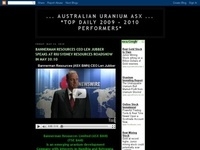Published on Monday Nov 22 2010
If global media reports are to be believed, uranium is all set to beat gold this year as far as price rise is concerned.
According to a report appeared in the new York Times, when Global X Funds of New York announced plans for two exchange-traded funds — one for gold stocks, the other, uranium, the one which got the maximum attraction was the uranium fund not the much-hyped gold.
Global X’s Uranium ETF — with holdings in companies like the Cameco Corporation, Paladin Energy and Uranium One — was a hit as soon as it went on sale on November 9, with early trading volume outpacing Global X’s gold ETF by five to one.
Again uranium industry insiders were caught off guard by a deep run-up in spot market prices, which are now about $58 a pound, up sharply from the low $40s in the summer.
It appears that the character of the spot market has changed markedly over the past few months from one that was heavily oversupplied with weak demand to one that has high levels of demand with very little supply, said a report in New York Times.
The price surge hints at a confluence of significant changes — a perfect storm now sweeping through the global nuclear power industry, especially in Asia. With China recently moving to accelerate sharply its nuclear building program by 2020 — the showpiece is the 3,300-megawatt Taishan plant in Guangdong Province, due to come online in 2013 — the country’s nuclear utilities are now trying to secure fuel supplies for years to come.
On November 1, China’s long-term planning agency announced that by 2020 it intended to raise nuclear power’s share of the country’s total energy production to 112 gigawatts, or 7 percent, up from the previous target of 70 gigawatts. That translates into an additional 82 million pounds of uranium.
Just as Global X’s uranium ETF went on sale, the French nuclear giant Areva signed a 10-year, $3.5 billion deal to supply 20,000 tons of uranium fuel to the China Guangdong Nuclear Power Corporation. Areva is a minority partner in the Taishan plant, described as the largest civil nuclear project ever. Cameco signed a similar deal earlier this year.
Russia, South Korea and Pakistan are also developing reactors and preparing to stockpile long-term inventories. The activity isn’t just domestic: China is reported to be helping Pakistan build five reactors, while South Korea recently won a large reactor project in the United Arab Emirates.
These moves contrast sharply with the situation in North America, where many nuclear projects are stalled because of economic uncertainty and a lack of government financing. Still, many analysts anticipate the Asian nuclear program will drive uranium prices to $70 to $80 a pound in the next several years — a level that will set off a new wave of exploration and mine development.
Lacking domestic uranium sources, China and companies like Paladin are also beginning to develop uranium mines in African countries including Namibia and Niger.
These latest developments are welcome news for uranium producers, some of which struggled in recent years after a mid-2000s boom was followed by a price collapse.
Over the last decade, Kazakhstan rapidly became the world’s largest uranium producer, overtaking Canada with vast increases in production.
Further complicating the picture was the fact that many nuclear utilities were acquiring fuel on the so-called secondary market — reprocessed uranium from decommissioned warheads, uranium tailings and spent reactor fuel.
Indeed, as 2010 draws to a tumultuous close, many uranium industry insiders are thinking ahead to the state of the market circa 2014 and beyond.
Visit my other site Australian Uranium Investing
 Australian Uranium News - Research
Australian Uranium News - Research

No comments:
Post a Comment